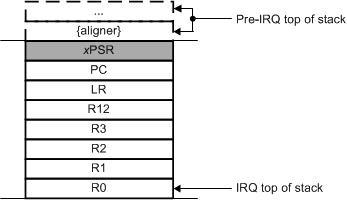SWCU192 November 2021 CC1312R7 , CC1352P7 , CC2652P7 , CC2652R7
6.1.7.1 Exception Entry
Exception entry occurs when there is a pending exception with sufficient priority and either the processor is in thread mode or the new exception is of a higher priority than the exception being handled, in which case the new exception preempts the original exception.
When one exception preempts another, the exceptions are nested.
Sufficient priority means the exception has more priority than any limits set by the mask registers (see PRIMASK on Priority Mask register, FAULTMASK on Fault Mask register, and BASEPRI on Base Priority register). An exception with less priority than this is pending but is not handled by the processor.
When the processor takes an exception, unless the exception is a tail-chained or a late-arriving exception, the processor pushes information onto the current stack (see Figure 6-2). This operation is referred to as stacking and the structure of eight data words is referred to as stack frame.
 Figure 6-2 Exception Stack Frame
Figure 6-2 Exception Stack FrameImmediately after stacking, the stack pointer indicates the lowest address in the stack frame.
The stack frame includes the return address, which is the address of the next instruction in the interrupted program. This value is restored to the PC at exception return so that the interrupted program resumes.
In parallel to the stacking operation, the processor performs a vector fetch that reads the exception handler start address from the vector table. When stacking completes, the processor starts executing the exception handler. At the same time, the processor writes an EXC_RETURN value to the LR, indicating which stack pointer corresponds to the stack frame and what operation mode the processor was in before the entry occurred.
If no higher priority exception occurs during exception entry, the processor starts executing the exception handler and automatically changes the status of the corresponding pending interrupt to active.
If another higher priority exception occurs during exception entry, known as late arrival, the processor starts executing the exception handler for this exception and does not change the pending status of the earlier exception.